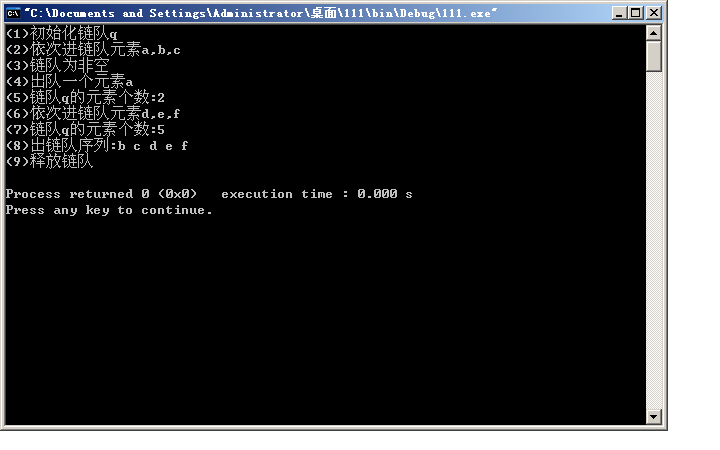数据结构第七周项目2--建立链队算法库
2017-12-14 10:21
190 查看
/*
*Copyright(c)2017,烟台大学计算机与控制工程学院
*All rights reserved.
*作 者:刘浩
*版 本 号:v1.0
*问题描述:定义链队存储结构,实现其基本运算,并完成测试。
*/
头文件:liqueue.h,包含定义链队数据结构的代码、宏定义、要实现算法的函数的声明:
[cpp] view
plain copy
#ifndef LIQUEUE_H_INCLUDED
#define LIQUEUE_H_INCLUDED
typedef char ElemType;
typedef struct qnode
{
ElemType data;
struct qnode *next;
} QNode; //链队数据结点类型定义
typedef struct
{
QNode *front;
QNode *rear;
} LiQueue; //链队类型定义
void InitQueue(LiQueue *&q); //初始化链队
void DestroyQueue(LiQueue *&q); //销毁链队
bool QueueEmpty(LiQueue *q); //判断链队是否为空
int QueueLength(LiQueue *q); //返回队列中数据元素个数
void enQueue(LiQueue *&q,ElemType e); //入队
bool deQueue(LiQueue *&q,ElemType &e); //出队
#endif // LIQUEUE_H_INCLUDED
源文件:liqueue.cpp,包含实现各种算法的函数的定义:
[cpp] view
plain copy
#include <stdio.h>
#include <malloc.h>
#include "liqueue.h"
void InitQueue(LiQueue *&q) //初始化链队
{
q=(LiQueue *)malloc(sizeof(LiQueue));
q->front=q->rear=NULL;
}
void DestroyQueue(LiQueue *&q) //销毁链队
{
QNode *p=q->front,*r; //p指向队头数据节点
if (p!=NULL) //释放数据节点占用空间
{
r=p->next;
while (r!=NULL)
{
free(p);
p=r;
r=p->next;
}
}
free(p);
free(q); //释放链队节点占用空间
}
bool QueueEmpty(LiQueue *q) //判断链队是否为空
{
return(q->rear==NULL);
}
int QueueLength(LiQueue *q) //返回队列中数据元素个数
{
int n=0;
QNode *p=q->front;
while (p!=NULL)
{
n++;
p=p->next;
}
return(n);
}
void enQueue(LiQueue *&q,ElemType e) //入队
{
QNode *p;
p=(QNode *)malloc(sizeof(QNode));
p->data=e;
p->next=NULL;
if (q->rear==NULL) //若链队为空,则新节点是队首节点又是队尾节点
q->front=q->rear=p;
else
{
q->rear->next=p; //将*p节点链到队尾,并将rear指向它
q->rear=p;
}
}
bool deQueue(LiQueue *&q,ElemType &e) //出队
{
QNode *t;
if (q->rear==NULL) //队列为空
return false;
t=q->front; //t指向第一个数据节点
if (q->front==q->rear) //队列中只有一个节点时
q->front=q->rear=NULL;
else //队列中有多个节点时
q->front=q->front->next;
e=t->data;
free(t);
return true;
}
在同一项目(project)中建立一个源文件(如main.cpp),编制main函数,完成相关的测试工作。 例:
[cpp] view
plain copy
<span style="font-family:SimSun;">#include <stdio.h>
#include "liqueue.h"
int main()
{
ElemType e;
LiQueue *q;
printf("(1)初始化链队q\n");
InitQueue(q);
printf("(2)依次进链队元素a,b,c\n");
enQueue(q,'a');
enQueue(q,'b');
enQueue(q,'c');
printf("(3)链队为%s\n",(QueueEmpty(q)?"空":"非空"));
if (deQueue(q,e)==0)
printf("队空,不能出队\n");
else
printf("(4)出队一个元素%c\n",e);
printf("(5)链队q的元素个数:%d\n",QueueLength(q));
printf("(6)依次进链队元素d,e,f\n");
enQueue(q,'d');
enQueue(q,'e');
enQueue(q,'f');
printf("(7)链队q的元素个数:%d\n",QueueLength(q));
printf("(8)出链队序列:");
while (!QueueEmpty(q))
{
deQueue(q,e);
printf("%c ",e);
}
printf("\n");
printf("(9)释放链队\n");
DestroyQueue(q);
return 0;
}</span><span style="font-family:microsoft yahei;">
</span>
结果:

*Copyright(c)2017,烟台大学计算机与控制工程学院
*All rights reserved.
*作 者:刘浩
*版 本 号:v1.0
*问题描述:定义链队存储结构,实现其基本运算,并完成测试。
*/
头文件:liqueue.h,包含定义链队数据结构的代码、宏定义、要实现算法的函数的声明:
[cpp] view
plain copy
#ifndef LIQUEUE_H_INCLUDED
#define LIQUEUE_H_INCLUDED
typedef char ElemType;
typedef struct qnode
{
ElemType data;
struct qnode *next;
} QNode; //链队数据结点类型定义
typedef struct
{
QNode *front;
QNode *rear;
} LiQueue; //链队类型定义
void InitQueue(LiQueue *&q); //初始化链队
void DestroyQueue(LiQueue *&q); //销毁链队
bool QueueEmpty(LiQueue *q); //判断链队是否为空
int QueueLength(LiQueue *q); //返回队列中数据元素个数
void enQueue(LiQueue *&q,ElemType e); //入队
bool deQueue(LiQueue *&q,ElemType &e); //出队
#endif // LIQUEUE_H_INCLUDED
源文件:liqueue.cpp,包含实现各种算法的函数的定义:
[cpp] view
plain copy
#include <stdio.h>
#include <malloc.h>
#include "liqueue.h"
void InitQueue(LiQueue *&q) //初始化链队
{
q=(LiQueue *)malloc(sizeof(LiQueue));
q->front=q->rear=NULL;
}
void DestroyQueue(LiQueue *&q) //销毁链队
{
QNode *p=q->front,*r; //p指向队头数据节点
if (p!=NULL) //释放数据节点占用空间
{
r=p->next;
while (r!=NULL)
{
free(p);
p=r;
r=p->next;
}
}
free(p);
free(q); //释放链队节点占用空间
}
bool QueueEmpty(LiQueue *q) //判断链队是否为空
{
return(q->rear==NULL);
}
int QueueLength(LiQueue *q) //返回队列中数据元素个数
{
int n=0;
QNode *p=q->front;
while (p!=NULL)
{
n++;
p=p->next;
}
return(n);
}
void enQueue(LiQueue *&q,ElemType e) //入队
{
QNode *p;
p=(QNode *)malloc(sizeof(QNode));
p->data=e;
p->next=NULL;
if (q->rear==NULL) //若链队为空,则新节点是队首节点又是队尾节点
q->front=q->rear=p;
else
{
q->rear->next=p; //将*p节点链到队尾,并将rear指向它
q->rear=p;
}
}
bool deQueue(LiQueue *&q,ElemType &e) //出队
{
QNode *t;
if (q->rear==NULL) //队列为空
return false;
t=q->front; //t指向第一个数据节点
if (q->front==q->rear) //队列中只有一个节点时
q->front=q->rear=NULL;
else //队列中有多个节点时
q->front=q->front->next;
e=t->data;
free(t);
return true;
}
在同一项目(project)中建立一个源文件(如main.cpp),编制main函数,完成相关的测试工作。 例:
[cpp] view
plain copy
<span style="font-family:SimSun;">#include <stdio.h>
#include "liqueue.h"
int main()
{
ElemType e;
LiQueue *q;
printf("(1)初始化链队q\n");
InitQueue(q);
printf("(2)依次进链队元素a,b,c\n");
enQueue(q,'a');
enQueue(q,'b');
enQueue(q,'c');
printf("(3)链队为%s\n",(QueueEmpty(q)?"空":"非空"));
if (deQueue(q,e)==0)
printf("队空,不能出队\n");
else
printf("(4)出队一个元素%c\n",e);
printf("(5)链队q的元素个数:%d\n",QueueLength(q));
printf("(6)依次进链队元素d,e,f\n");
enQueue(q,'d');
enQueue(q,'e');
enQueue(q,'f');
printf("(7)链队q的元素个数:%d\n",QueueLength(q));
printf("(8)出链队序列:");
while (!QueueEmpty(q))
{
deQueue(q,e);
printf("%c ",e);
}
printf("\n");
printf("(9)释放链队\n");
DestroyQueue(q);
return 0;
}</span><span style="font-family:microsoft yahei;">
</span>
结果:

相关文章推荐
- 数据结构第七周项目一-建立链队算法库
- 数据结构 第七周 项目二 建立链队算法库
- 第七周数据结构之自建算法库——顺序环形队列【项目2 - 建立链队算法库】
- 第七周 项目2 - 建立链队算法库
- 第七周-项目二-建立链队算法库
- 第七周项目2-建立链队算法库
- 第七周项目2 - 建立链队算法库
- 第七周项目2-建立链队算法库
- 第七周项目2——建立链队算法库
- 第七周—项目2 - 建立链队算法库
- 第七周项目2-建立链队算法库
- 第七周 项目2 - 建立链队算法库
- 第七周 项目二 建立链队算法库
- 第7周SHH数据结构—【项目2 - 建立链队算法库】
- 第七周 项目2-建立链队算法库
- 第七周项目2-建立链队算法库
- 数据结构第七周项目(二)——建立连队算法库
- 第七周 项目2 建立链队算法库
- 第七周 【项目2 - 建立链队算法库】
- 第七周 项目二 建立链队算法库
